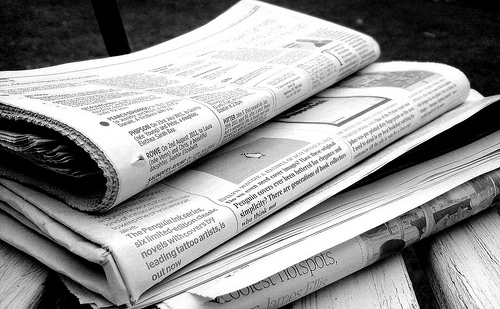Let’s learn a lesson from the past. When the news first started going digital, that is when it started appearing on the World Wide Web and print saw it as a competitor that would give the product away for free. The digital prophets saw a future in which free wouldn’t matter, and said things along the lines of, “If we don’t eat our young, someone else will.” In many ways, we could say they were right — or at least we can say we still don’t know.
The O.C. Register is moving forward with a print-first strategy, even while the Journal Register Co. is moving forward with a digital-first effort. This may be a new twist on the old East Coast/West Coast rivalry, but the answer probably lies in the middle, and in a way most don’t expect.
Think about what print has going for it and what digital has going for it. Both have a lot of advantages, and both don’t need to work against each other any more than an eraser on a pencil works against the delete key on your laptop.
It’s about the design
 At right are the comparative sizes of several print formats and the common Apple-handled devices, the iPhone and the iPad.
At right are the comparative sizes of several print formats and the common Apple-handled devices, the iPhone and the iPad.
Do you see what I see? The print canvases are massive in comparison to the digital canvas. Without batteries or retinal displays, the 150, 200, and 300 dpi resolutions are finer than any computer screen.
But we fill these giant design spaces primarily with columns and columns of gray text.
The digital side is continuously updated and fresh. It is interactive and responsive. The print side is anywhere from 12 to 24 hours to a week to a month old by the time it reaches a consumer’s hands. It’s static and unchanging.
We are starting to get our heads around the ideas of the web of things and the geolocated web, but we still really don’t know how to make print and digital work together in a complimentary or smart way. We’ve gone from url teasers to QR codes, but the print tease message is still the same: For more, go online.

USA Today, the paper that upended the industry with a groundbreaking use of color when it first went on the market, last month redesigned its print product as … a print product. It has new logos and fonts, yet the layout and format are still a newspaper. How could a broadsheet product be designed like a magazine that integrated, not just tried to push traffic to, a digital presence? What would USA Today look like if it opened up to a double-truck map of the United States peppered with photos, smart headlines, and compelling abstracts and QR codes that worked with a native companion app that took the reader to the freshest version of the topic or story?
If we look through the amazing work awarded by the Society for News Design, we know that the industry has the potential to blow us off our seats with compelling visual storytelling, but paging through visual media in online photo galleries buries content in a linear fashion. Why not put the photos on the big canvas and put the text on the handheld?
Instead of holding to the convention that we write shorter for the web and longer in print, perhaps the really innovative strategy is to use the print product like outdoor advertising that drives people specifically to the stories they’re interested in.
Leading together
Maybe it really isn’t about print or digital first, but leading together, side by side. The mantra of the web has always been more powerful and successful when it is collaborate, not compete. Why compete with each other? Why should any product go first, when both can cross the finish line at the same time if they work together?
The smart answer isn’t putting digital or print first, but to put design and usability first, using each product for what they do best and let them do it together.
David Johnson is a full-time professor of journalism at the American University School of Communication. He teaches courses in digital journalism, interactive storytelling and convergence media. His research interests include social networking and media, behavioral economics and serious games. He is the editor-in-chief of The American Observer, the school’s online magazine. Johnson has been creating award-winning online content since the first graphical browsers were introduced in the early 1990s. Before coming to AU, he was chief technology officer of Scripps Media Center in Washington DC, home to Scripps Howard News Service. He is a founding member of the Media Bloggers Association and has blogged on the media at lostremote.com since 1999 and is now a contributor to the Poynter Institute’s E-Media Tidbits blog. Johnson sits on the New Media Committee and Broadcasting Task Force at the National Press Club and consults frequently on niche and community site development.

